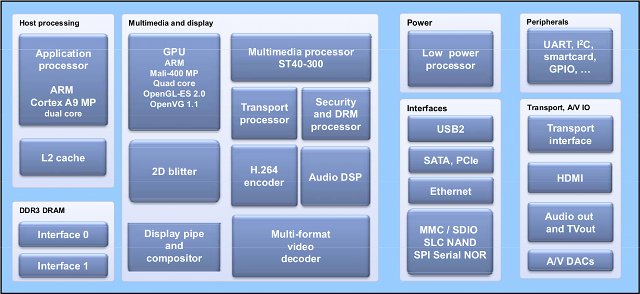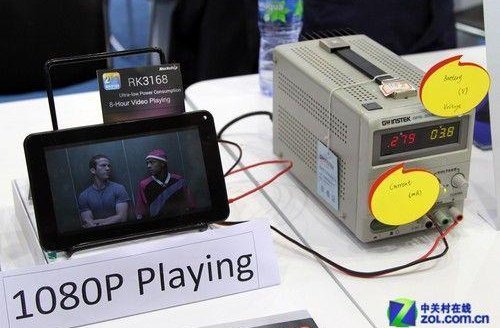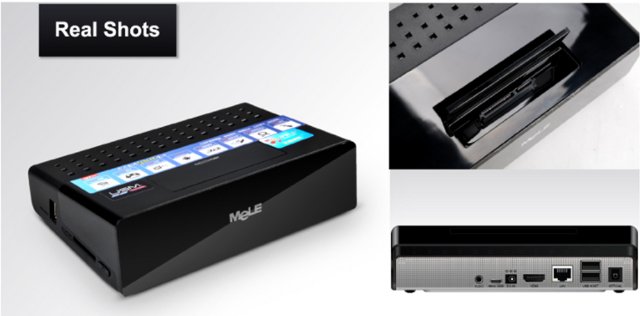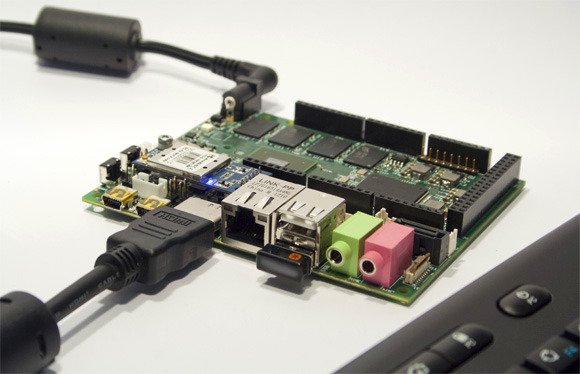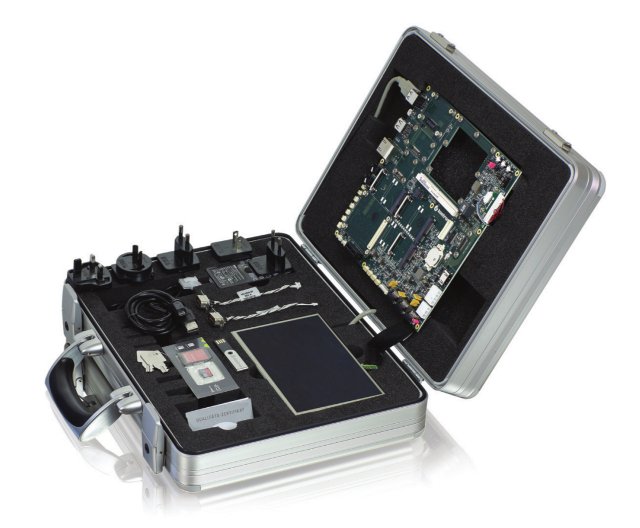STMicro announced STiH416 SoC for media players at CES 2012 with very few details, but we’ve still known that it is a dual core Cortex A9 @ 1.2 GHz coupled with a quad core Mali-400 manufacturer and an hardware video decoder supporting commonly used codecs such as H.264, VC-1, AVS and MPEG2. Yesterday they put out a press release about a STB development platform based on this solution, and I found out we’ve got much more information now. Key features include: ARM Cortex-A9, dual core CPU, SMP NEON SIMD engine yielding up to 6000 DMIPS ARM Mali-400 quad core GPU yielding up to 1600 Mpixels/s fill rate and supporting up to 1080p60 or 1080p30 stereoscopic 3D graphics Dual HD H.264/VC-1/AVS/MPEG2 video decoder or SVC video decode MVC video decode for 3DTV: supports up to 1080p60L/60R, 3D video formats Dual HD internet video decoding: real video 8/9/10, DivX, Xvid, MP4p2, Adobe […]
Booting Linux in Less Than 1 Second in AllWinner A10 Devices? Yes! You Can!
threewater, a Chinese developer, has just posted a very interesting demo on linux-sunxi mailing list showing a device based on AllWinner A10 boot linux within 0.85s, and if you add a Qt app, the total time is just about 1.2s. This appears to be a custom hardware (EM6000), but we do know it’s based on AllWinner A10, comes with 512 MB RAM, and 4GB NAND Flash. On the software side, the device runs kernel 3.4 from linux-sunxi, with a customized version of uboot, a squashfs rootfs, and a Qt 4.7.4 app showing a gauge. Both the rootfs (7MB) and the kernel (2MB) have been compressed with LZO. All that boots from NAND flash for optimal speed. The 1.2 second time includes kernel + rootfs + app time, and the total time is a bit longer, but this is still impressive. Here’s the boot log:
|
1 2 3 4 5 6 7 8 9 10 |
[1.690000 1.690000] U-Boot SPL 2013.01-05984-g2120a27-dirty (Apr 17 2013 - 14:22:02) [0.009000 0.009000] Board: EM6000 [0.012000 0.003000] DRAM: 512MB [1.014000 1.002000] init startup v1.1 [1.016000 0.002000] mount usr data error 2 [1.158000 0.142000] Could not read calibration: "/data/etc/pointercal" [1.166000 0.008000] Couldnt open tslib config file: No such file or directory [1.175000 0.009000] QWSTslibMouseHandlerPrivate: ts_config() failed with error: 'No such file or directory' [1.187000 0.012000] Please check your tslib installation! [1.200000 0.013000] qt show |
If you just boot to […]
How to Detect if an ARM ELF Binary is Hard-float (ARMHF) or Soft-float (ARMEL)
If some cases you may want to know if a library or binary built for the ARM architecture is using hard-float (armhf) or soft-float (armel). You can analyze ELF binary using readefl utility, so let’s have a try. First let’s install some armel and armhf files on a computer running Ubuntu by install gcc/g++ toolchain for armel and armhf:
|
1 |
apt-get install g++-arm-linux-gnueabi g++-arm-linux-gnueabihf |
We now have armhf and armel libraries installed in /usr/arm-linux-gnueabihf/lib and /usr/arm-linux-gnueabi/lib respectively. Let’s check the output of readelf filtered with “FP” string for libm.so.6 for armel:
|
1 2 3 4 5 6 7 |
readelf -a /usr/arm-linux-gnueabi/lib/libm.so.6 | grep FP Tag_FP_arch: VFPv3-D16 Tag_ABI_FP_denormal: Needed Tag_ABI_FP_exceptions: Needed Tag_ABI_FP_number_model: IEEE 754 Tag_ABI_HardFP_use: SP and DP |
and armhf:
|
1 2 3 4 5 6 7 8 |
readelf -a /usr/arm-linux-gnueabihf/lib/libm.so.6 | grep FP Tag_FP_arch: VFPv3-D16 Tag_ABI_FP_denormal: Needed Tag_ABI_FP_exceptions: Needed Tag_ABI_FP_number_model: IEEE 754 Tag_ABI_HardFP_use: SP and DP Tag_ABI_VFP_args: VFP registers |
Great, so there’s an extra line for armhf (Tag_ABI_VFP_args) that seems to confirm the library is hard-float. With readelf compiled from elftoolchain-0.6.1 (source code), the extra line will be a bit different: “Tag_ABI_VFP_args: AAPCS (VFP variant) AAPCS stands for ARM Architecture Procedure Call Standard. You can read more details on ARM website. There are also two other possible values […]
How to Use Libhybris and Android GPU Libraries with Mer (Linux) on the Cubieboard
You may have heard about libhybris, a library that cleverly loads Android HW adaptations and convert calls from bionic to glibc. One of the greatest achievement of this library is to allow Android GPU drivers to be used with Linux, and is notably used by Canonical, although they did not write it, for Ubuntu 14.04 which will be compatible with any recent Android smartphones or tablets. One way to get started with libhybris is to port a device to Ubuntu Touch, but this may take a while. However, I’ve found a faster and easier way to play with libhybris thanks to Martin Brook (vgrade) who wrote a tutorial on how to use libhybris with Mer on the Cubieboard. Mer is an open source mobile Linux distribution powered by Qt/QML and HTML5, that’s born from the ashes of Meego, and is now used in the upcoming Sailfish OS. You’ll need to […]
Rockchip Unveils RK3168 Dual Core Processor, Showcases $10 Miracast Adapter
Rockchip is currently at the Hong Kong Electronics Fair showing off their RK3188 quad core processor, and corresponding products such as tablets, gamepads, HDMI TV dongles, etc… Business seems good as they already received orders for 800k pieces in about a month, and they expect to sell 10 to 15 millions over the course of the year. The company had also a few RK3066 devices on display, but more interestingly they announced RK3168, which also a dual core Cortex A9 processor, but with lower power consumption thanks to 28nm HKMG process, instead of the 40nm process used for Rockchip RK3066. They have a tablet prototype without battery connected to a power supply to show the power consumption, and the tablet under test consumes 280mA @ 3.8V (About 1 Watt) when decoding 1080p videos with the display brightness set to about 50%. Chen Feng, Vice President at Rockchip, explains that with […]
Mele A1000G Quad Set-Top Box Features AllWinner A31 SoC
Mele A1000 Android set-top box based on AllWinner A10 is one the best platform to play with Linux on ARM, thanks to its low cost, numerous features, hackability, and the work of the developers’ community on arm-netbook mailing list, and now in sunxi-linux. I like it so much it’s the first item in my short list of hackable gadgets. However, the hardware specifications of the original Mele A1000 may be too weak for some of today’s applications. So I’m pleased the announce that Mele A1000G Quad is now available (for pre-order) with AllWinner A31 quad core Cortex A7 SoC, 2GB RAM and 8GB Flash. Here are the specifications for Mele A1000 Quad STB: SoC – AllWinner A31 quad core Cortex A7 @ 1.5GHz + PowerVR SGX544MP2 GPU System Memory – 2GB DDR3 RAM Storage 8GB Flash SD card slot SATA connector (most probably via a USB to SATA chipset) Video […]
UDOO Single Board Computer Features Freescale i.MX6 Dual/Quad and Atmel SAM3 MCU
Have you ever dreamed of a single board with the power of 4 Raspberry Pi and Arduino Due functionality? This dream should soon become reality thanks to UDOO single board computer. This open source hardware board is powered by Freescale i.MX6 Dual or Quad with 1GB RAM, as well as Atmel SAM3 Cortex M3 MCU that provides access to Arduino compatible headers. Here are the specifications of the board: SoC – Freescale i.MX6 ARM Cortex-A9 CPU Dual/Quad Core @ 1GHz + Vivante GPU MCU – Atmel SAM3X8E ARM Cortex-M3 (same as Arduino Due) System Memory – 1GB DDR3 Storage – micro SD (boot device) + SATA (i.MX6 Quad only) Video Output – HDMI and LVDS + Touch (I2C signals) Audio I/O – Analog Audio and Mic Expansion Headers – 54 Digital I/O + Analog Input (Arduino-compatible R3 1.0 pinout) Connectivity Ethernet RJ45 (10/100/1000 MBit) WiFi Module USB – mini USB […]
Kontron Unveils SMARC Starterkit for ARM Systems-on-Module
You may have previously heard about ULP-COM (Ultra Low Power CoM), a standard for systems and computers on module. The standard has been ratified by the Standardization Group for Embedded Technologies (SGET) in February 2013, and renamed to SMARC (Smart Mobility ARChitecture). This standard is specifically designed for low power designed, and is currently only used with ARM SoC. Kontron was involved in the design of this standard, released several ULP-COM, now SMARC, compatible CoM based on TI, Freescale and Nvidia SoC, and yesterday the company just announced SMARC Starterkit will all hardware and software components needed to get started with evaluation and development. This starter kit comes in a carrying case with the following items: SMARC Evaluation Carrier Board 7″ Display PM070W4 (WVGA – 800×480) Touch USB Kit ETP04USBR Mounting Kit Adapter and Cables: 1x Kontron LVDS Jili30 Adapter incl. cable 1x DSUB9 1x micro USB USB A Storage […]


